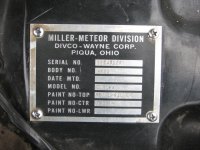did I miss something we jumped from the DMV to insurance. the DMV even in SD doesn't not have the box to check for hearse or ambulance in the one size fits all computer program they now use. you got to call it a station wagon to get the right body style. that and if you insist it's a hearse they want to sell you commercial tags for it. the same computer program is the one that insists you have the digits in the vin number. if the old title in PA was off the superior or MM or what ever it is number, you'll have to change it to the gm vin number. under the glass, on top of the frame in the rear and on the engine is all the locations so far. anyone have one more??
Miller Meteor didn't make sure that the cowl number matched the frame and engine numbers when they built the cars, so these numbers might not match with the cowl number. I learned this when I went looking for the engine number on my 1969 MM ambulance. While I was at the meet in Piqua, I asked one of the MM plant employees, and he explained that the chassis was delivered without the cowl, and then the cowl was delivered on a separate truck. If they got in 20 frames, then they got 20 cowls on that truck. They stored the cowls in a building across from the manufacturing plant, and would just get one when they started to build a body, without regard for anything except if it had air condition or not. That is because the cowls were different in that respect.






